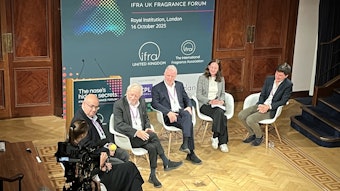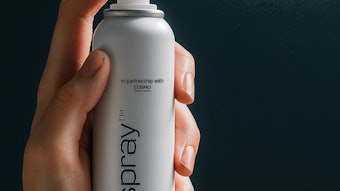
Givaudan has introduced MoodScentz, a fragrance technologies platform designed to guide perfumers and creative teams in crafting mood enhancing fragrances to evoke positive emotions.
MoodScentz was developed, with the initial aim to explore the potential of fragrances in increasing emotional well-being. Since then, it has significantly evolved under Givaudan’s Scentz platform as the latest neuroscience techniques have allowed for better understanding of the underlying mechanisms that take place in the human brain in the presence of odors.
Previously: Givaudan Rates in Top 1% in FTSE4Good Index
MoodScentz is a set of fragrance creation guidelines based on combinations of ingredients with mood benefits to design fragrances with a focus on three moods:
- Relaxing: brings peace of mind and serenity
- Invigorating: encourages an uplifted and energized feel
- Happy: inspires a feeling of positivity and delight
The patented technologies blend psychological and neuroscientific measurement techniques with perfumery expertise resulting in fragrances that are said to offer the consumer real emotional benefits.
Previously: Givaudan Enters Research Partnership with Novozymes
Givaudan scientists have translated the connection between scents and sentiments by using multi-dimensional statistical techniques. Mood research at Givaudan’s Health and Wellbeing Centre of Excellence in Ashford, United Kingdom, suggests that a scent can bring a positive state of mind, creating a positive mood that can be beneficial to an individual’s well-being.
To further measure the consumers’ response to different fragrances, researchers at Givaudan have developed and used Mood Portraits to uncover deeper links between fragrance and emotion through images. This technique involves asking volunteers to select the visuals that represent emotions evoked by a fragrance, avoiding the use of words—eliciting a more spontaneous and discriminatory response.
Previously: Givaudan Awarded EcoVadis Platinum Medal
Jeremy Compton, global head of science and technology fragrances, said, “Now, more than ever, it is vital for us to discover our own ways to happiness, relaxation or to energize. We are delighted to introduce our innovative technology MoodScentz. Over the years, it has been enhancing the way fragrances are created to deliver real emotional benefits to consumers. Aligned to our company’s purpose of creating for happier, healthier lives with love for nature, MoodScentz fragrances are helping our consumers boost their positive feelings and helping overcome negative mood states—our personal emotions are so important in these unprecedented times.”
Perfumer & Flavorist+ was able to sit down with Julia Brooks, Givaudan’s business support scientist, to discuss the new technology in greater detail:
![Perfumer & Flavorist+ [PF+]: How do the Mood Portraits help to give more accurate information over worded responses?](https://img.perfumerflavorist.com/files/base/allured/all/image/2020/12/gci.300x300_Julia-Brooks.png?auto=format%2Ccompress&fit=max&q=70&w=400) Perfumer & Flavorist+ [PF+]: How do the Mood Portraits help to give more accurate information over worded responses?
Perfumer & Flavorist+ [PF+]: How do the Mood Portraits help to give more accurate information over worded responses?Julia Brooks [JB]: Trygg Engen, a pioneer in the psychology of olfaction, said in 1982, “People have difficulty in communicating about smell experiences through words.” Typical consumer research not only uses words but also uses numerical scales, requiring consumers to apply a numerical value to how they are feeling. Different brain functions are required to apply a numerical and verbal value to how we feel. People are also naturally reluctant to reveal their true emotions for fear of being judged and so direct questioning is more likely to lead to poorer accuracy in the resulting data. Selecting images is a more implicit way to access true emotions. By using pictures as a proxy scale, this bypasses the need to label or rate the emotion, and means consumers are responding more intuitively to their emotional responses to fragrances. We have consistently, over the years, obtained consumer evidence to show that classic verbal mood attribute scaling tends to correlate with the hedonic ratings, with rarely any significant differences between the moods such as invigorating and relaxing. Mood Portraits, in contrast, consistently differentiates between the moods, with the pictures providing greater granularity between the different aspects of the same mood; for example, relaxing mood, cosy quite relaxation the fire or carefree outdoors relaxation with the family. These differences are very compelling when related to the specific odor directions which drive these different emotional responses.
PF+: How does MoodScentz account for individual experience/association? Are there outliers that will simply experience the scent differently from the majority of users?
JB: MoodScentz technology, based on country specific data, is comprised of creative design rules which provide flexibility for our perfumers to design perfumes for general or specific consumer groups (eg. millennials, mothers with babies, adolescent men). Most of our clients develop products for a broad target consumer group, and our aim is to deliver fragrances which support our clients’ product needs and testing with sufficient consumers ensures this. There is always scope for outliers, people who will experience the scent differently from the majority of other users, as this reflects generally the range of the human experience. We see this manifest itself in a rise in the number of bespoke niche products appearing in the marketplace.
PF+: How does MoodScentz help perfumers to create complete fragrances?
JB: The MoodScentz creative guidelines not only guide our perfumers to include specific ingredients they also consider the complete fragrance and the combination of those ingredients within the fragrances. The perfumers are able to screen their creations/formulations to check they comply with the guidelines during the creative phase to ensure the fragrances retain their mood evoking properties throughout the whole development stage.










